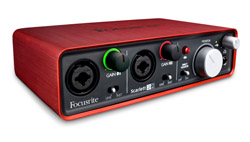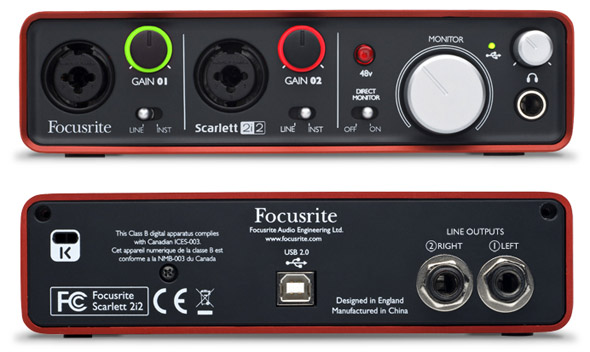The Focusrite Scarlett 2i2 caught my attention right away. Compact, striking appearance and simple layout.
I have recommended the interface to dozens of people.
While I appreciate the extra I/O my TC Impact Twin provides, its just too big and bulky for a mobile interface.
At a third of the size of the Impact Twin, and less than half the cost, the 2i2 jumped to the top of my gear wish list, and I made the purchase last week.
This will be a fairly quick review, sort of a “first impressions” look at the interface as I’ve only had it for a few days, but I don’t want to put off writing something about it.
Scarlett 2i2 Features
—2 balanced inputs – front panel combo jacks – mic/line/instrument
—2 balanced outputs with monitor level control – rear panel TRS
—Headphone output with volume control
—+10 to +55 dB gain range for preamps
—Halo signal and overload metering on inputs
—Phantom power button
—Switchable line/input for each input
—Direct monitor switch
—USB2
—96 kHz max sample rate
—Red anodized aluminum unibody case
—Includes USB cable, Scarlett plug-in suite (EQ, Compressor, Gate, Reverb)
Appearance & Construction
The 2i2 is definitely eye catching with the red anodyzed aluminum case. The feel is very solid, it’s not heavy but has just enough weight to it to not feel like a toy.
The halo metering around the gain knobs is very cool, space saving and effective. The large monitor knob is nice but plastic, as with the headphone knob and the switches. The gain knobs are rubberized and feel better. Not a big deal though.
Sound Quality
The Scarlett has a very clean, detailed sound, and with plenty of gain. Usually interface preamps at this price point are very weak or noisy, that’s not the case here at all. I haven’t tested scientifically but with my usual podcasting mic direct into the 2i2, there’s much less noise. Hmm, maybe my usual (and expensive) preamp is broken.
With the instrument inputs we come to the first potential problem. With my Telecaster it’s pretty easy to clip the preamp, not clipping constantly but too much for passive pickups.
With higher output guitars this would be even more of an issue, possibly being completely unusable with active guitars. Switching the mode to line in indeed drops the gain but also the impedance and really changes the tonality and response for the worse.
The solution to this problem would be to use a separate DI with a pad and go into the mic preamp.
Headphone output adds no noticeable noise and is more than loud enough to cause discomfort or pain.
Latency/Stability
I haven’t had any problems with it yet on OSX Lion. The day I got it I was playing guitar through it at 32 sample buffer for a couple hours without any clicks or dropouts. I saw some complaints on Amazon about driver issues but those were from users on XP, likely with old computers too.
Scarlett Plug-In Suite
For some reason I couldn’t get the VST versions to work in Reaper. I could see them in the folder but they weren’t found. I tried the AU versions fairly quickly and can’t say they’re going to be much use to anyone. They look really nice, of course they do, White Tie did the GUIs. But in my opinion they don’t offer anything special or really any better than what comes with most DAWs. I will probably uninstall them.
Summary
For $150 I was expecting to be disappointed with the sound. This one far exceeds the quality of other compact interfaces in the price range, or double, like the original PreSonus Audiobox or Mbox 2 or any compact M-Audio interface. A few episodes ago on the podcast, the topic was audio interfaces and this was one of my recommendations. Having made the investment I still stand by that, it’s excellent. It’s really just the gain range of the Hi-Z inputs that I can complain about, though it feels silly to complain about having TOO MUCH gain on a preamp.
Score: 9/10
More Info On The Focusrite Scarlett 2i2
Jon Tidey is a Producer/Engineer who runs his own studio, EPIC Sounds, and enjoys writing about audio on his blog AudioGeekZine.com. To comment or ask questions about this article go here.






















